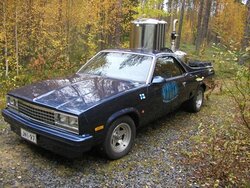I've been going over some of the build threads for some time concerning wood gas boilers that various members here have put together for themselves. Absolutely fascinating stuff and some excellent workmanship to boot so compliments and true admiration to all the builders.
What led me down the path of wanting to build my own is that wood gassifcation is more flexible than just as a method for heating up water. Has anyone here experimented with drawing off the wood gas from their self manufactured units prior to combustion for other uses? For example, I've stuck together gassifiers and filtered the wood gas to run internal combsution engines (small scale stuff - 8HP - in order to experiement with 12V electricity generation) - it's easy as pie and there's so much literature on it now that it's like following a "For Dummies" yellow book.
I'd like to build a fairly large wood gas unit where I can draw off the wood gas when I'm not using it to heat my water storage system and instead use the gas in a modified genset to co-produce (in grid tie fashion) electricity and offset my major utility expense. I own several rental houses that are on lots adjacent my own and in my utopian wood gas world I'd like to start supplying wood gas based heat and grid tie electricity to each of them. I've decided to start with my own and the one rental physically closest to me.
I've seen the first stabs at some attempts of commercialization of wood gas co generation on a small scale but none of it has made it's way into the mainstream despite various announcements.
I've done grid tie systems from other sources before (solar, wind) and I've had no problems passing my work before the ESA (electrical standards authority here in Ontario) for approval so I'm not the least bit worried about that aspect. Where I lack know how is on the boiler side and there seems to be a ton of that here.
Has anyone envisioned something multi purpose like this ? I'm thinking I could build a wood gas boiler based on some of the member approaches I've seen here with a modified approach to the combustion chamber that lets me (whenever I chose) to suck off the wood gas and use it elewhere.
My primary purpose is heat and DHW in keeping with the forum with a secondary purpose of generating electricity.
I'd be interested in thoughts or imput, areas of concern, aborted approaches, discussion points... whatever.
Regards,
Ugly
What led me down the path of wanting to build my own is that wood gassifcation is more flexible than just as a method for heating up water. Has anyone here experimented with drawing off the wood gas from their self manufactured units prior to combustion for other uses? For example, I've stuck together gassifiers and filtered the wood gas to run internal combsution engines (small scale stuff - 8HP - in order to experiement with 12V electricity generation) - it's easy as pie and there's so much literature on it now that it's like following a "For Dummies" yellow book.
I'd like to build a fairly large wood gas unit where I can draw off the wood gas when I'm not using it to heat my water storage system and instead use the gas in a modified genset to co-produce (in grid tie fashion) electricity and offset my major utility expense. I own several rental houses that are on lots adjacent my own and in my utopian wood gas world I'd like to start supplying wood gas based heat and grid tie electricity to each of them. I've decided to start with my own and the one rental physically closest to me.
I've seen the first stabs at some attempts of commercialization of wood gas co generation on a small scale but none of it has made it's way into the mainstream despite various announcements.
I've done grid tie systems from other sources before (solar, wind) and I've had no problems passing my work before the ESA (electrical standards authority here in Ontario) for approval so I'm not the least bit worried about that aspect. Where I lack know how is on the boiler side and there seems to be a ton of that here.
Has anyone envisioned something multi purpose like this ? I'm thinking I could build a wood gas boiler based on some of the member approaches I've seen here with a modified approach to the combustion chamber that lets me (whenever I chose) to suck off the wood gas and use it elewhere.
My primary purpose is heat and DHW in keeping with the forum with a secondary purpose of generating electricity.
I'd be interested in thoughts or imput, areas of concern, aborted approaches, discussion points... whatever.
Regards,
Ugly




